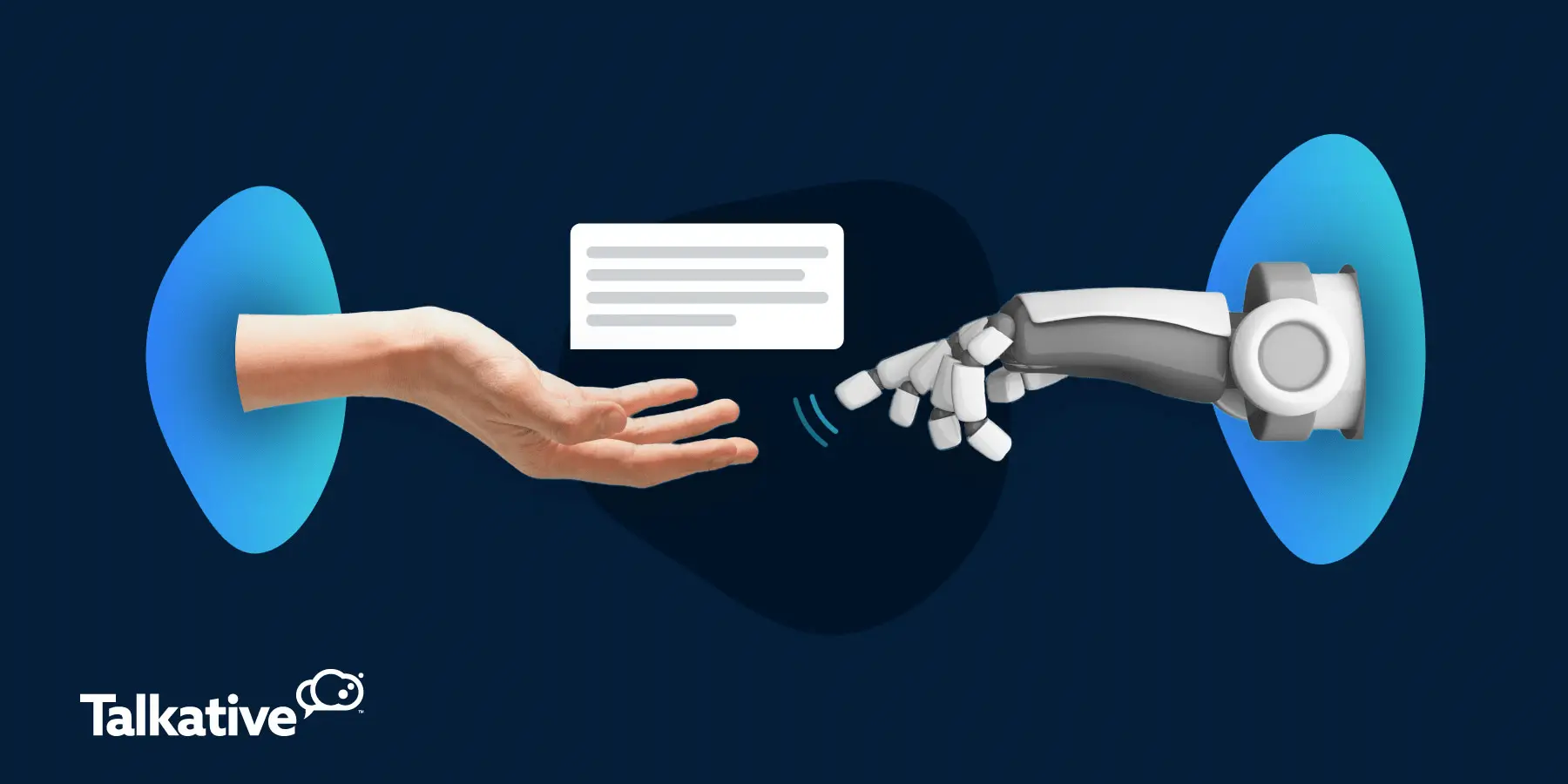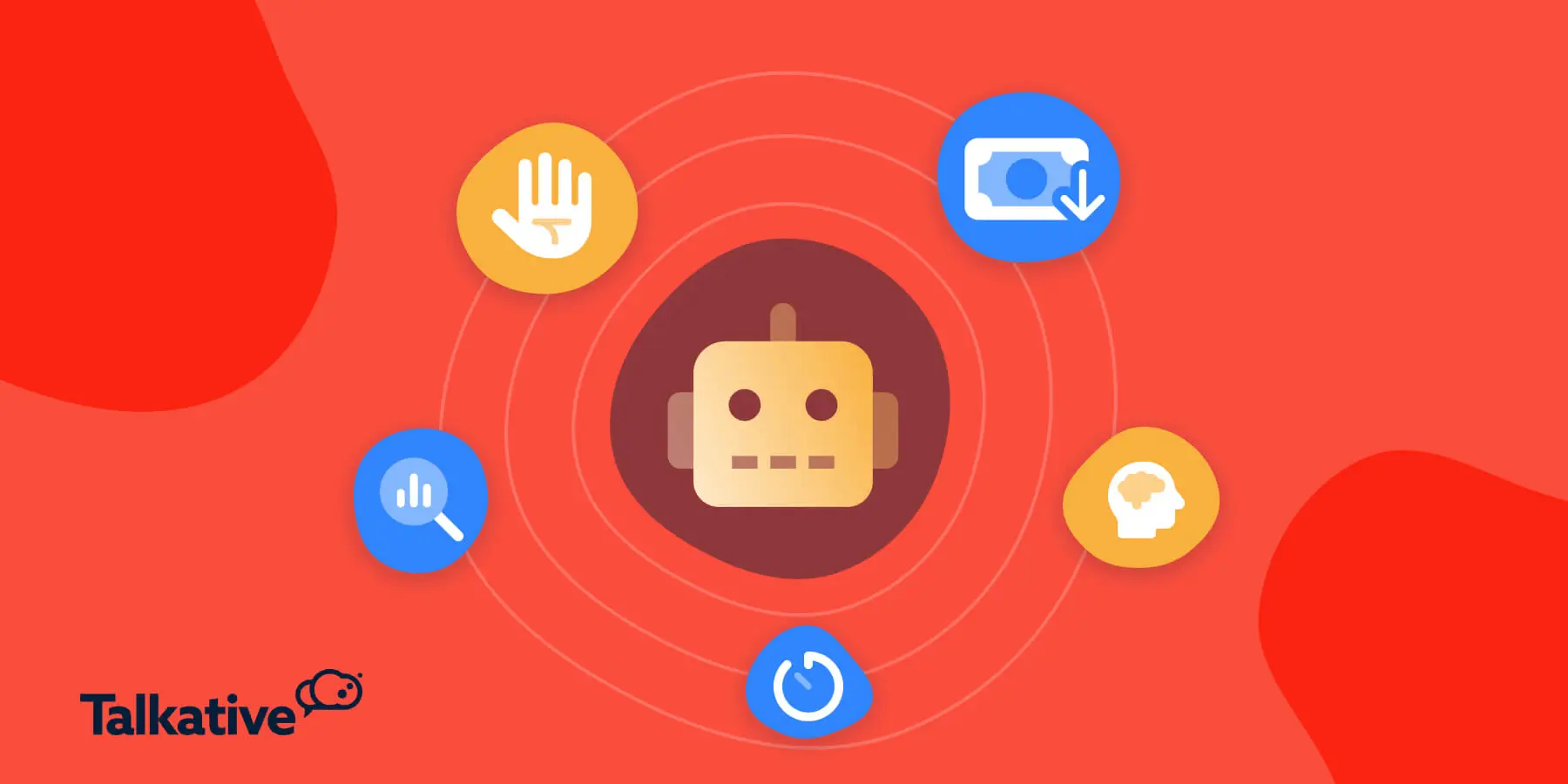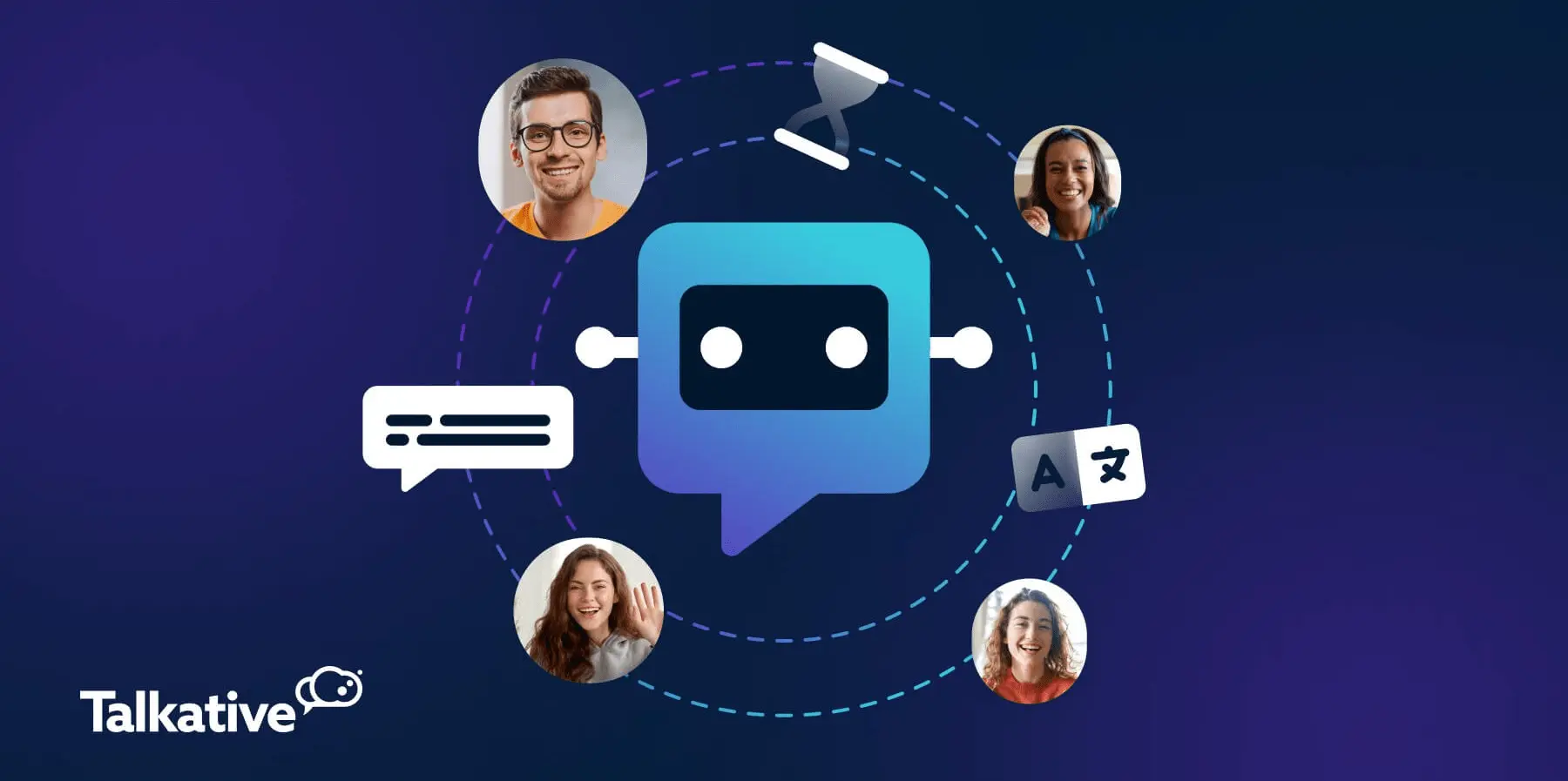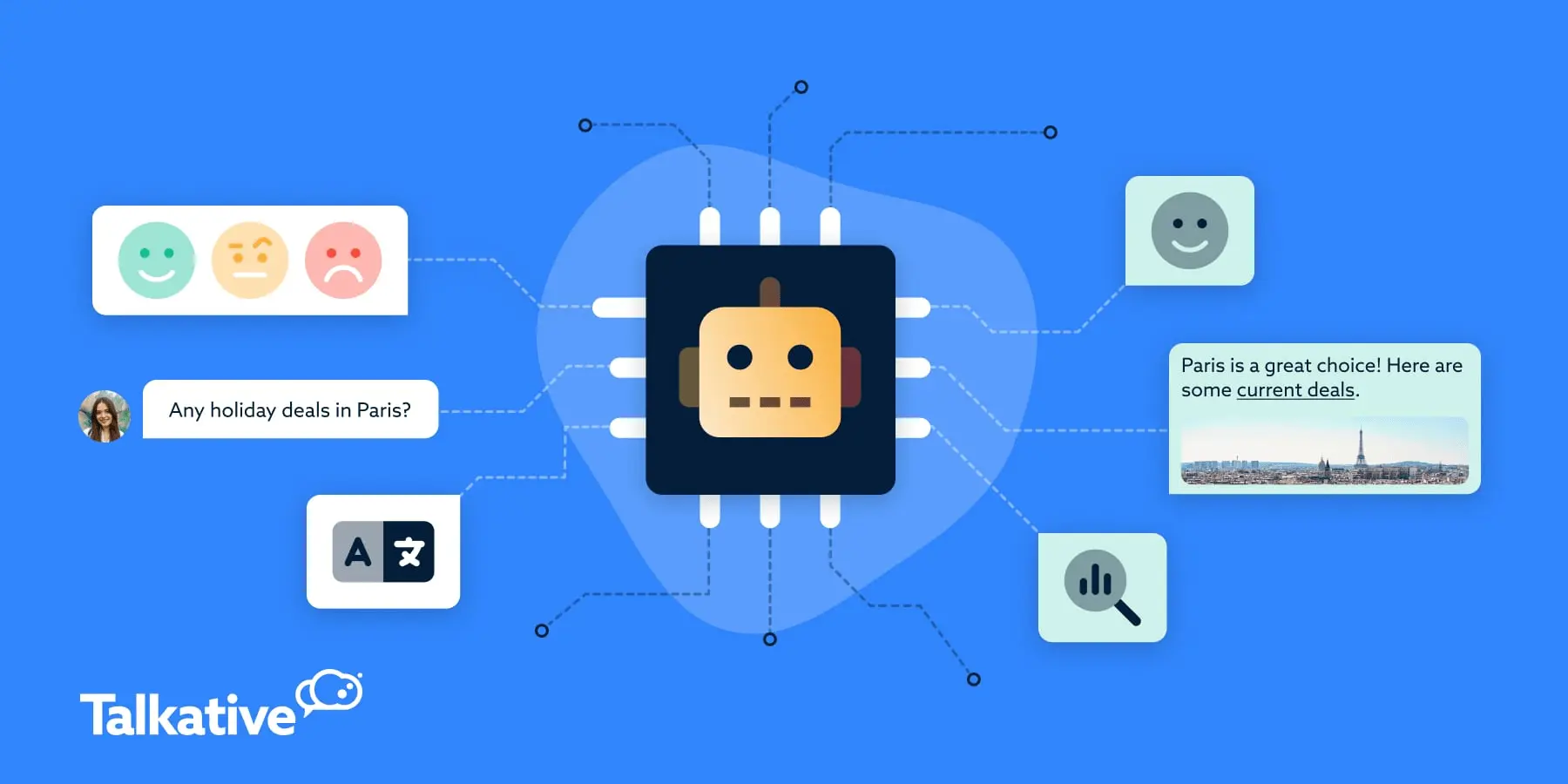AI has been a hot topic for some time now, with the release of OpenAI’s ChatGPT adding fuel to the fire.
As consumers everywhere become familiar with these technologies and embrace the AI frenzy, businesses have gained a unique opportunity to use AI to their advantage.
It’s why 83% of companies have made implementing AI a top priority in their business strategies.
But what does this mean for the future of contact centres, customer support, and the digital CX?
Do AI innovations really live up to the hype?
And how can you actually use AI to transform customer service and improve efficiency?
In this article, we’ll answer these questions and provide a realistic guide to getting the most out of AI - without claiming that these tools are a customer service cure-all.
We’ll cover:
- What is customer service AI, and how does it work?
- How to use AI in customer service operations: 6 examples
- The benefits of implementing AI in customer service
TL;DR
With technologies like conversational AI, NLP, ML, and GenAI, businesses can maximise efficiency and productivity while enhancing customer service quality.
6 examples of AI in customer service functions:
- AI-powered Chatbots: Advanced chatbots powered by AI can automate tasks, interactions and escalations, reducing customer service costs and providing a seamless user experience.
- AI Assistive Tools: AI-powered tools can help agents in real time by offering response suggestions and guidance, increasing productivity and accuracy.
- AI Interaction Transcripts: AI can generate accurate transcripts of voice or video interactions, aiding in performance management, training, and compliance.
- AI Reporting & Analytics: AI-driven analytics automate reporting and provide valuable insights into support performance, enabling targeted improvements.
- Sentiment Analysis: AI analyses text to determine the underlying emotional tone, allowing businesses to monitor customer and agent sentiment.
- Real-Time Translation: AI facilitates real-time translation during chat interactions, breaking language barriers and providing inclusive customer service.

What is customer service AI?
Simply put, AI in customer service operations is the use of artificial intelligence technologies to refine, streamline, and automate customer support.
In this context, implementing AI boosts productivity, improves performance, and enhances the digital customer experience.
It achieves this by handling a range of customer service tasks and interactions, assisting agents during customer conversations, and analyzing data for businesses.
By automating these processes, AI empowers businesses to be much more efficient through time-saving and reducing the demand for human support agents.
It also helps customers by optimising self-service options and ensuring that any human-powered support they need is faster and highly accurate.
AI in customer service has evolved dramatically since the days of decision trees and rule/intent-based models.
Nowadays, AI solutions are often powered by more advanced conversational AI technologies like natural language processing (NLP), machine learning (ML), and/or generative AI (GenAI).
These AI technologies serve different purposes - let’s break them down.

Natural Language Processing
Natural Language Processing (NLP) is used by conversational AI models to understand and interpret human language.
This enables the AI to comprehend and respond to customer queries and customer requests in a way that feels natural to the user.
It also means that AI can process large amounts of text-based content and employ data extraction techniques.
NLP algorithms analyse the structure and meaning of sentences, extracting relevant information to provide accurate and contextually appropriate information or responses.

Machine Learning
Machine Learning (ML) allows an AI system to learn from experience and the data/information you put into it.
With ML algorithms, AI tools can be trained using vast datasets, such as interaction transcripts and knowledge base articles (more on this later).
ML-powered customer service solutions can also recognise patterns, make predictions, and improve their performance over time.

Generative AI
Generative AI (GenAI) refers to deep-learning models that can create new text, images, or other content.
This makes an AI system much more versatile, giving it the ability to comprehend and respond to a wider range of queries/inputs.
With GenAI, customer service bots can go beyond predefined responses, producing highly detailed and accurate outputs in a conversational manner.
These outputs are not directly copied from existing data but are generated based on the user query plus the information learned during training.

How to use AI in customer service: 6 examples
Now that we’ve covered the basics of AI in customer service, let’s explore six key examples of this technology.
1. AI Chatbots
Chatbots are probably the most common example of implementing AI in customer service.
These systems used to rely solely on decision trees and pre-scripted responses when assisting customers, often leading to frustration and a poor user experience.
Now, thanks to AI advancements, chatbots have evolved to become versatile and intelligent virtual agents - capable of automating huge amounts of customer service tasks and queries.
As a result, chatbots can now reduce customer support costs by as much as 30%.
An AI chatbot works by using NLP, machine learning, and/or generative AI to understand user messages and produce detailed, human-like, instant responses.
One of the ways they do this is through integration with your knowledge base. For instance, with Talkative’s GenAI Chatbot, you can import URLs from your company website into your own AI knowledge base - plus any file-based resources.
From there, the bot can learn from your website/knowledge base content and answer countless questions about your business, products, and services.
AI chatbots can be deployed across your website, app, and social media channels to automate huge volumes of customer requests without intervention.
Of course, even AI chatbots have limitations. That’s why they can also initiate seamless handoffs to a customer service agent whenever a user does need human assistance.
It means your customers can access optimal self-service and the best chatbot experience possible - without losing the option to speak to a human if needed.
2. AI assistance for customer service agents
Contrary to popular belief or fears, AI isn’t here to replace human-powered support - nor should it ever be considered a replacement.
Instead, AI should be viewed as a technology that can support agents by empowering them to perform better and be more productive.
AI tools achieve this by providing your customer service team with real-time assistance, information and recommendations during interactions.
With Talkative, you can take advantage of the following AI assistive tools:
- Knowledge base responses: This feature allows you to create and train an AI-powered knowledge base using URLs from your website and other content (e.g. articles, documents, spreadsheets, etc). Once set up, the AI can extract information from your knowledge base content and use it to automate response suggestions for customer queries - just like with an AI chatbot.
- AI Agent Copilot: Knowledge Base responses are one component of our AI Agent Copilot suite. Powered by OpenAI and your knowledge base datasets, this feature is a set of AI tools for agents. In addition to response suggestions, Agent Copilot provides 'Navi', an internal-facing chatbot that acts as a personal AI assistant for agents. It also offers an AI Autocomplete capability that can predict and complete agent messages, facilitating faster responses.
- AI Agent Rephrases: Powered by generative AI, Agent Rephrases work by offering improved or revised versions of agent messages during chat interactions. This means that, instead of having your agents manually edit and proofread each live chat message themselves before sending it, the AI does all the work for them. Agents can even choose a preferred tone/style (better spelling/grammar, longer, shorter, friendlier, or more professional) for the rephrases.
These tools not only accelerate response and resolution times but also help ensure that agents provide accurate and consistent information.
It’s for this reason that 81% of contact centre leaders are now investing in agent-assistive AI.

3. AI reporting & analytics
One of the things AI excels at is processing vast amounts of information very quickly in order to extract meaningful patterns or trends.
This means that AI can automate reporting, helping you gain detailed insights into analytics, efficiency, and the performance of your customer service teams.
Not only does this save a lot of time, but it also ensures high accuracy and consistency in your performance management.
AI content analysis can further enhances these capabilities by utilising NLP to extract insights from interaction or other textual data, providing valuable information on sentiment trends, common topics, and customer behaviour.
This enables businesses to enhance marketing strategies and improve customer service through targeted approaches.
With Talkative, AI reporting and analytics can be utilised in various ways, including (but not limited to):
- Monitoring performance: AI analytics can be used to track and analyse a range of performance metrics, such as Average Response Time, CSAT score, and First Contact Resolution rate. You can use this information to make data-driven improvements and reduce churn.
- AI Interaction Summaries: Reviewing customer interactions can be a lengthy process. Although AI transcripts (see section below) speed this up, AI interaction summaries take it a step further by condensing an entire conversation into a few sentences. These concise summaries allow you to assess the content and outcome of any interaction at a glance. With Talkative, this capability is powered by our OpenAI integration, which provides automatic summaries of every chat, voice, and video interaction.
- AI Insights Reports: With the help of AI, you can quickly and easily generate comprehensive reports that delve deeper into your interaction data. For example, with the Talkative solution, you can use a powerful Large Language Model (LLM) to analyse your interaction transcripts and automatically create AI insights reports. These reports outline the top 10 issues raised by customers in the past week/month (with an example interaction for each issue) and highlight any queries that an AI bot could potentially automate.
- AI Knowledge Gap Report: With this report, you can view all the questions customers have asked your chatbot - plus whether or not the bot was able to answer them using your AI Knowledge Base. This means you can quickly identify gaps in your knowledge base content and make data-driven improvements.
- AI Analytics assistant: Our Analytics Assistant allows you to create reports through conversational interactions with an internal-facing chatbot. It can generate any report supported by Talkative analytics and can even answer questions like “What’s the average chat duration for this week?” or "What were our CSAT scores last month?".
With AI-driven reporting/analytics, you can save time on reporting and gain a comprehensive insight into the effectiveness of your support strategy.
These insights will enable targeted improvements - keeping you on track to reach your customer service goals.
That being said, you may have concerns about sharing your interaction data with OpenAI. With all this information being processed and generated, how can you be sure that your company data is secure?
But, rest assured - no data is stored or used by the LLM and all identifying metadata (e.g. company name, agent name, etc.) is stripped out of the interactions before they're sent to OpenAI.
Naturally, there's a degree of scepticism out there regarding LLMS's use of user data. As a new technology, these kinds of concerns are only sensible.
However, OpenAI's enterprise privacy policy describes in detail how data is secured - so it's a useful read for peace of mind.

4. AI video interaction transcripts
Many customer service interactions occur through voice or video communication channels.
Revisiting these conversations can be time-consuming if your only option is to watch or listen to a recording.
Fortunately, you can leverage the power of generative AI and NLP to convert audio recordings into a text-based format.
With Talkative, for example, you can use AI to generate a highly accurate written transcript for every video chat and/or web call.
These AI transcripts are a valuable resource that can be used for the following purposes:
- Qaulity assurance: Supervisors can review transcripts to evaluate agent performance and identify areas needing improvement or further training. They can also ensure that agents adhere to company guidelines and deliver high-quality service.
- Training/onboarding: Transcripts provide real-world examples of customer interactions, allowing new agents to review and understand how experienced call centre agents handle various situations.
- Data analysis: Transcripts can be analysed for valuable insights into the customer support experience. With Talkative, you can even search for specific words or phrases within a transcript, allowing you to find the information you need instantly.
- Compliance: Transcripts can be used for compliance and legal purposes, serving as detailed audit trails of customer-agent interactions. By reviewing transcripts, you can ensure agents are complying with industry regulations and standards.
Ultimately, AI-generated transcripts allow you to review previous interactions more efficiently, with greater speed and convenience.

5. Sentiment analysis
Sentiment analysis is an application of AI used to determine the emotion or attitude expressed within a piece of text.
In the context of customer service, this technology allows businesses to monitor agent and customer sentiment during interactions.
It works by using NLP and machine learning to identify the underlying tone of communication - whether that be positive, negative, or neutral.
AI sentiment analysis is useful because it indicates overall customer satisfaction, agent effectiveness, and the quality of your customer support.
Below are some examples of how sentiment analysis can aid customer support operations:
- Live chat monitoring: Sentiment analysis can be used during live chat customer service to monitor the sentiment of messages in real time. This allows supervisors to flag any issues or concerns before they escalate and take appropriate action.
- Chatbot monitoring: In addition to live chat, advanced sentiment analysis like Talkative’s can also analyse chatbot interactions. This provides insights into chatbot performance, improving customer satisfaction towards your bot.
- Agent performance: With Talkative, you can analyse agent sentiment as well as customer sentiment during chat interactions. This helps you monitor agent performance, ensuring they communicate appropriately and positively with customers.
- Customer feedback: Sentiment analysis can be applied to customer feedback/reviews, helping you proactively identify customer complaints and make impactful improvements to your customer service process.
Overall, sentiment analysis is an invaluable customer service tool, enabling businesses to understand customer perceptions, improve agent communication, and evaluate the customer experience.

6. Real-time translation
If your organisation is a global brand or one that serves a diverse customer base, it’s crucial that you provide multilingual customer support.
AI allows you to do this by facilitating real-time translation during chat interactions.
When a customer uses a different language than your agents, AI translation technology can instantly recognise this, identify the language used, and translate the messages.
Then, when the agent sends a response back to the customer, that message is automatically translated back into the customer’s native tongue.
This process allows you to eliminate language barriers and provide an inclusive customer service experience - without hiring human translators or multilingual agents.
It also empowers your support teams to communicate effectively and efficiently in any language, creating a seamless experience for your clients overseas.
What’s more, multilingual live chat can help build brand loyalty by demonstrating a commitment to accessibility and customer relations.
That’s why the Talkative solution includes automatic, real-time translation into over a hundred languages - for both live chat and chatbot interactions.

Benefits of using AI tools for customer support
By leveraging AI in customer service effectively (with the help of the above examples), you can achieve the following outcomes…
Increased efficiency & productivity
AI in customer service can be a game-changer when it comes to contact centre efficiency and agent productivity.
In fact, the impact of AI technologies is projected to increase business productivity by up to 40%.
What’s more, 60% of call centre agents report that AI helps them save time.
Implementing AI can boost agent efficiency and productivity in the following ways:
- Automation: AI in customer service can automate repetitive tasks and countless customer interactions, reducing workload volume for support agents and leaving them with more time. This leads to faster resolutions and improved response times for the customers who need it most.
- Agent assistance: As we’ve covered, AI assistive tools like Google Agent Assist can aid your support team during interactions by offering real-time guidance, information, and response suggestions/recommendations. It’s why agents who use contact centre AI can handle 14% more queries per hour compared to those not using AI.
- 24/7 productivity: An AI customer service chatbot doesn’t need rest or days off, meaning it can support and serve your digital customers around the clock. This also creates ultimate accessibility, allowing users to get instant assistance whenever they need it - whatever their schedule or location.
- Scalability: AI systems excel at accommodating fluctuations in customer service requests. Whether it’s a sudden surge in chat interactions or a busy period like the festive season, AI can easily adapt to help you manage the workload more efficiently.
When leveraged effectively, AI in customer service offers numerous ways to save time and optimise the handling of customer support requests - leading to a streamlined system that’ll keep both your customers and agents happy.

A better customer experience
When used alongside human-powered support, customer service AI can play a pivotal role in improving the customer experience.
In fact, according to HubSpot research, 62% of customer service specialists agree that AI helps them serve their customers better.
Thanks to AI chatbots and AI knowledge bases, consumers can enjoy 24/7 automated support and instant access to advanced self-service tools.
Intelligent AI virtual assistants are great at analyzing customer data and communicate in a conversational way, creating a more humanised experience and engaging experience.
It’s why AI has been shown to increase the usage of self-service channels by 2-3x.
Moreover, with the help of AI-powered assistance and recommendations, customer service teams can anticipate customer needs, communicate more effectively, personalize customer interactions, and solve problems faster.
In summary, AI tools enhance the customer experience by fine-tuning chatbot support, giving consumers better self-service options, and empowering human agents to deliver better service.

Empowered customer service teams
As we’ve covered, AI doesn’t just improve the customer experience - it also improves the agent experience by empowering them to perform better and faster.
Case in point, research suggests that AI customer service solutions can boost employee performance by 66%.
With AI customer support software, agents can gain real-time assistance, AI-driven recommendations, and instant access to relevant information during interactions.
This saves a lot of time for agents and helps ensure accuracy, facilitating faster responses and resolutions.
And, with AI automating numerous tasks/interactions and optimising self-service, the overall workload for your support teams will lessen.
This reduces the risk of customer service burnout, leading to higher employee morale. Plus, it’ll give your agents more time to dedicate to the customers who need the human touch.

The takeaway
Whether you’re optimistic or dubious about AI in customer service, it’s clear that these emerging technologies are here to stay.
The abilities and popularity of AI customer service solutions are only going to continue to grow.
Businesses must be willing to embrace the future and meet customer expectation - or risk getting left behind.
Fortunately, Talkative can help you get started.
As we’ve covered, our AI customer service platform offers a variety of AI solutions - from advanced AI-powered chatbots to Agent Copilot, sentiment analysis, AI-powered reporting/analytics, real-time translation, and much more.
Built with growing brands in mind, you can gain enterprise-grade AI features at a fraction of the usual cost with Talkative - and scale your usage without any nasty price jumps.
In addition to AI solutions, we offer a suite of customer contact channels and capabilities - including live chat, web calling, video chat, cobrowse, and messaging.
It means you can deliver an AI-powered customer service experience - without breaking the bank or completely stripping away the human touch.
Want to learn more?
Book a demo with Talkative today, and check out our interactive product tour.



